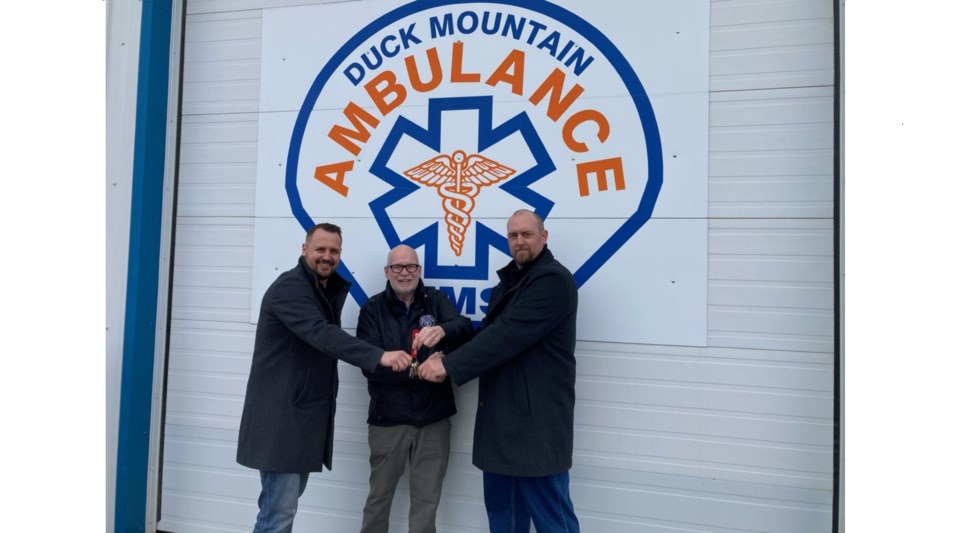KAMSACK — It was a casual conversation a decade ago between Duck Mountain Ambulance’s previous owner Jim Pollock and brothers Curtis and Ryan Monette that sparked an official acquisition this April by Aspen Paramedic Services.
“We wish Jim all the best and a happy retirement,” said Curtis, who is the owner/operator at Aspen with his brother Ryan. “We look forward to getting out there and meeting more people in some of the communities that'll be new to our service area.”
Duck Mountain Ambulance served Kamsack, Norquay, Watson and areas. Before the acquisition, Aspen Paramedic Services served Canora, Preeceville and area.
Having worked with Pollock for years, the acquisition lends the existing service flexibility to distribute assignment workload and maintain on-call emergency coverage in the towns covered, Curtis said.
“Right now we're not really looking at coming in and changing a bunch of things,” he said. “But we want to learn how things are operating and look for different efficiencies… and keep more and more ambulances on the road in our communities.”
In addition to managing the logistics between towns, the burning needs of the community and the scarce resource combined puts a strain on the operations, leaving the brothers no room for pondering the long-term future in detail.
“We're still trying to figure out this week,” Ryan said when asked about their plans ahead. “...geographically and strategically, with our current service, because we're already so entwined with our units back and forth.”
With stabilization of the current resources being the top priority, still, the brothers said they are looking to expand by advocating for longer open hours at health facilities and increasing the amount of ambulances.
Several times, the staffed ambulances are tied up outside the area because no local health facilities are open to accept the patients when calls come in, Curtis said, which means ambulances have to come from other communities to respond and add hours to their time on a task.
“We have nowhere else to go or to transport a patient to,” Curtis said.
“Hospitals are normally open 24/7 for acute care inpatients and emergency department (ED) services,” emailed a spokesperson with the Saskatchewan Health Authority (SHA). “However, if a facility has no available physician, registered nurse or lab services, the facility will be on an ED service disruption.”
The SHA says their ongoing efforts in preventing emergency department service disruptions include recruitment and retention of staff and physicians where there are vacancies, such as the Virtual Physician model and Point of Care Testing.
And while the open hours of the local hospitals are a work-in-progress, the paramedics and the SHA are working closely on a community paramedicine program called ‘pre-hospital care’ to reduce the amount of 911 and emergency calls needed through preventative patient care.
Back at the Aspen base in Canora, the brothers are hoping to have full resources to avoid scrambling around with multiple roles.
“We do have vacant positions that we've been struggling to fill,” said Curtis.
Just like other ambulance services in the rest of the country, with a small team of around 20 full-time workers covering five towns, Aspen Paramedic Services is exhausting its current staff and in urgent need of more skilled workers.
The brothers mentioned they are planning emergency medical responder courses for the public to recruit locally, which entails a few years of education and training to obtain legal licensure in the province.
“What we're trying to do now is actually just establish a roster of people who are interested, so we can hopefully offer the course locally here and get a group together,” Ryan said.
With much happening with limited staff and resources at hand and inundated with calls, the brothers shook their heads when asked about their work-life balance and said they find ways to live with the ambulances.
A typical day for the brothers, Ryan said, starts with a remote status-update meeting with other services and facilities in the province, to in-person base meetings with the crews.
“It’s always interesting,” said Ryan.
“What makes it worthwhile is knowing we're able to be in a position to help people when they need it,” Curtis added.
On Sundays the brothers sit down and split the responsibilities, learning and bringing themselves up to speed with the area’s needs, given they have just taken over the operations.
“We're either travelling together or on the phone 40 times a day with each other,” he said.
Ryan brought up his daughter who was at home with the flu on the day of the interview, saying he only got to spend some time with her in the morning.
“(Sometimes) you'd have to have another ambulance base to cover on an ambulance to go working on an ambulance. Our work depends on the day and things change on a daily or weekly basis…” Curtis said of their schedule of the day before being cut off by a call to get an ambulance into service.
All Saskatchewan residents are encouraged to never delay calling 9-1-1 in an emergency even if they believe the health facility closest to them is in disruption.



